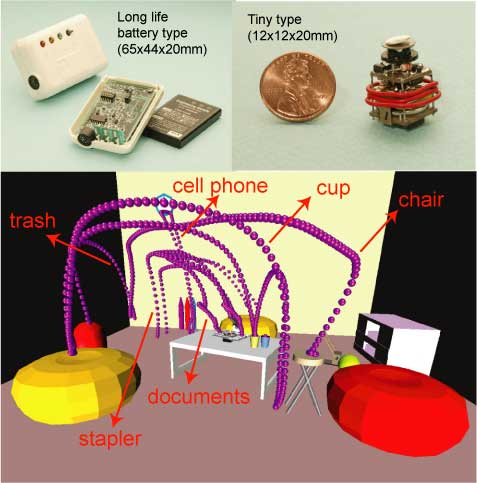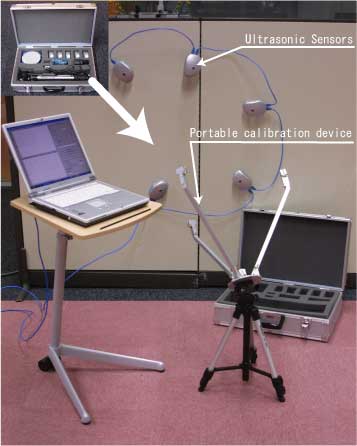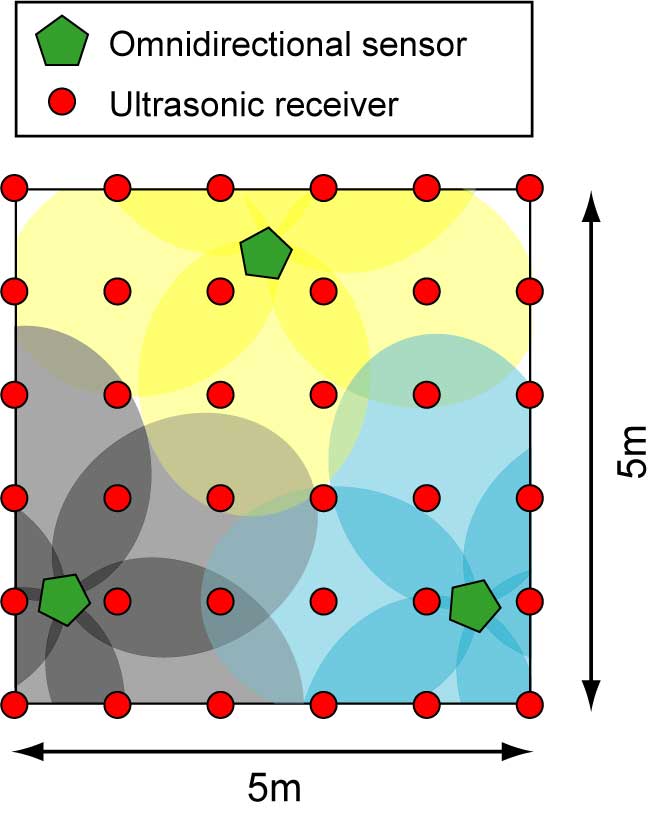Research>Enabling Environment
Ultrasonic 3D Tagging System :
Technology for Observing Human Activity in the Order of Centimeters
Outline
Technology for observing human activity is essential for the creation of smart spaces that provide human-centered services. Much research has been conducted into such behavior observation systems, but until now problems with stability, operability and cost have prevented the widespread application of the systems that have been created. In an effort to address these problems, the Digital Human Research Center developed a system called Three-Dimensional Ultrasonic Tagging, which uses ultrasound to observe human activity. We then productized this technology through joint research with industry (
Furukawa Industrial Machinery Systems Co., Ltd.) and have begun to supply external organizations.
Introduction
Much research is currently being conducted around the globe into smart living spaces that provide human-centered services by using sensors embedded into the environment to observe human activity. Human activity monitoring technology is essential for the creation of such smart spaces. Being able to take measurements accurately and reliably in the places where people actually live and work, such as homes, factories, hospitals and offices, is very important. Observation systems also need to be inexpensive and quick to set up. The following is an introduction to Three-Dimensional Ultrasonic Tagging, the living environment sensorization technology that our research center has developed for the observation of human activity.
Sensorization Technology for the Observation of Human Activity in Living Environments
While technology that is only accurate to within the order of a meter limits observations to the level of determining which room a person is in, the ability to observe human activity in the order of centimeters allows us to describe everyday movements such as using a remote control or getting out of bed. On the other hand, it would require a very expensive system to accurately observe such activity in the order of millimeters. For these reasons we developed our ultrasonic three-dimensional tagging system to allow the observation and analysis of human activity in the order of centimeters. In this system, objects and people are fitted with ultrasonic three-dimensional tags (small ultrasound transmitters) that emit ultrasound waves which are then measured by a number of receivers positioned on the ceiling and walls. The system calculates the three-dimensional location of an ultrasonic tag from the difference in the time it takes for the signal to reach each receiver. Our system costs 1/10th to 1/100th of the price of commercially available systems that are capable of calculating location in the order of millimeters. Figure 1 shows our ultrasonic three-dimensional tags and an example of paths plotted using objects fitted with these tags.

Figure: 1 Our ultrasonic three-dimensional tags
Portable ultrasonic three-dimensional tag system with quick set-up
When attempting to observe human activity in a space like a home or an office, it is essential to have a system that can be set up quickly. A vital part of the set-up process is the accurate placement of the receivers. Through our research, we developed the portable ultrasonic tagging system shown in figure 2. We developed a method whereby receivers can be positioned simply by moving around the three or more transmitters connected to this device.

Figure 2: Portable ultrasonic three-dimensional tagging system
Cost-reducing omni-directional ultrasonic location sensor
No matter how inexpensive your ultrasonic sensors are, if you have to install a large number of them, labor costs associated with installation will drive up your overall system costs. In an effort to reduce the number of installations necessary, we developed the omni-directional ultrasonic location sensor shown in figure 3. Featuring receivers positioned on the vertices of a polyhedron, this sensor is able to make measurements in all directions. Figure 4 shows how these omni-directional ultrasonic location sensors would be positioned in a 5 m × 5 m room. Compared to conventional ultrasonic receivers, which needed to be installed in large numbers, only three of these omni-directional ultrasonic location sensors are necessary, resulting in a dramatic reduction in the labor associated with the installation of receivers.

Figure 3: Omni-directional ultrasonic location sensor

Figure 4: Detection range of omni-directional ultrasonic location sensors (grey, blue and yellow)
Summary
At the Digital Human Research Center, we are already working towards our next goal, that of applying human observation technology powered by ultrasonic three-dimensional tagging to the creation of “enabling environments”.
These environments would be used to allow people to do things that otherwise would not be possible, to allow people to perform difficult tasks easily, or conversely to help prevent people from doing things that they should not do.
The many possible applications of such technology include protective environments and skill-enhancing environments, which are important in aging societies and international society respectively. At the Digital Human Research Center, we have been working with
Furukawa Industrial Machinery Systems Co., Ltd. to productize our ultrasonic three-dimensional tagging system and related technology, and have begun to supply this technology to external organizations for use as a tool in research into smart spaces, and as elemental technology for applications based on human observation.
参考文献
- 西田佳史,堀俊夫,金出武雄, "超音波3次元タグを用いた日常環境のセンサ化とその応用," ケミカルエンジニアリング, Vol. 50, No. 7, pp. 520-526, 2005
- Y. Nishida, K. Kitamura, T. Hori, A. Nishitani, T. Kanade, H. Mizoguchi, "Quick Realization of Function for Detecting Human Activity Events by Ultrasonic 3D Tag and Stereo Vision," Proc. of 2nd IEEE International Conference on Pervasive Computing and Communications (PerCom2004), pp. 43-54, 2004
- 西田佳史, "行動観察システムの手早い構築法とその応用," 画像ラボ (2004年1月号), Vol. 15, No.1, pp. 38-41, 2004
- Y. Nishida, H. Aizawa, T. Hori, N.H. Hoffman, T. Kanade, M. Kakikura, "3D Ultrasonic Tagging System for Observing Human Activity, " in Proceedings of IEEE International Conference on Intelligent Robots and Systems (IROS2003), pp.785-791, October 2003
- A. Nishitani, Y. Nishida, H. Mizoguchi, "Omnidirectional Ultrasonic Location Sensor," in Proceedings of 2005 IEEE International Conference on Sensors (Sensors 2005), October 2005 (in press)
- A. Nishitani, Y. Nishida, T. Hori, T. Kanade, H. Mizoguchi, "Global Calibration Based on Local Calibration for an Ultrasonic Location Sensor," in Proceedings of 1st International Conference on Sensing Technology (ICST2005), pp. 11-16, 2005




